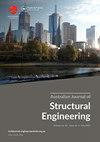改良两段混合方式对混合法处理再生骨料的影响
IF 0.9
Q4 ENGINEERING, CIVIL
Australian Journal of Structural Engineering
Pub Date : 2022-03-17
DOI:10.1080/13287982.2022.2048479
引用次数: 2
摘要
由于对混凝土的需求不断增长,自然资源的消耗正在迅速减少。因此,本研究在混凝土中采用再生骨料(RA)替代经过适当处理的天然骨料(NA)。在目前的工作中,研究了其新鲜、硬化和耐用性能。再生骨料(RA)的粘结砂浆由于吸水率增加而强度降低,使其等级降低。文献表明,天然骨料混凝土(NAC)比再生骨料混凝土(RAC)具有更好的强度和耐久性。在使用RA制造混凝土时,使用两阶段混合方法(TSMA)比普通混合方法(NMA)更好地改善RAC性能。本研究考察了不同的搅拌方法对处理过的再生骨料(TRA)混凝土的影响。在这项工作中使用了四种不同的混合变体(即NMA, TSMA, TSMA1, TSMA2)。天然骨料(NA)在所有变体中以不同的替代水平被TRA替代,包括0%、25%、50%、75%和100%的M40对照混合物。实验结果表明,与所有其他混合技术相比,TSMA2混合方法提高了TRA混凝土的强度和界面过渡区(ITZ)等各项性能。本文章由计算机程序翻译,如有差异,请以英文原文为准。
Influence of modified two-stage mixing approaches on recycled aggregate treated with a hybrid method of treatment
ABSTRACT The depletion of natural resources occurs at a rapidly decreasing rate due to the growing demand for concrete. Therefore, the current research study uses recycled aggregate (RA) in concrete as a replacement for natural aggregate (NA) after proper treatment. The fresh, hardened, and durability properties have been examined in the current work. The adherent mortar over recycled aggregate (RA) makes it lower grade due to increased water absorption and lower strength. Based on Literature, natural aggregate concrete (NAC) has better strength and durability properties than recycled aggregate concrete (RAC). While making concrete using RA, using a two-stage mixing approach (TSMA) improves RAC properties better than the normal mixing approach (NMA). This study examines the influence of different mixing methods on concrete made from treated recycled aggregate(TRA). Four different mixing variants (viz. NMA, TSMA, TSMA1, TSMA2) were used in this work. The natural aggregate (NA) was replaced with TRA at various replacement levels in all variants, including 0%, 25%, 50%, 75%, and 100% in a control mix of M40. Based on the experimental results, the mixing method TSMA2 improved the various properties like strength and interfacial transition zone (ITZ) of TRA concrete compared to all other mixing techniques considered.
求助全文
通过发布文献求助,成功后即可免费获取论文全文。
去求助
来源期刊

Australian Journal of Structural Engineering
ENGINEERING, CIVIL-
CiteScore
2.50
自引率
0.00%
发文量
31
期刊介绍:
The Australian Journal of Structural Engineering (AJSE) is published under the auspices of the Structural College Board of Engineers Australia. It fulfils part of the Board''s mission for Continuing Professional Development. The journal also offers a means for exchange and interaction of scientific and professional issues and technical developments. The journal is open to members and non-members of Engineers Australia. Original papers on research and development (Technical Papers) and professional matters and achievements (Professional Papers) in all areas relevant to the science, art and practice of structural engineering are considered for possible publication. All papers and technical notes are peer-reviewed. The fundamental criterion for acceptance for publication is the intellectual and professional value of the contribution. Occasionally, papers previously published in essentially the same form elsewhere may be considered for publication. In this case acknowledgement to prior publication must be included in a footnote on page one of the manuscript. These papers are peer-reviewed as new submissions. The length of acceptable contributions typically should not exceed 4,000 to 5,000 word equivalents. Longer manuscripts may be considered at the discretion of the Editor. Technical Notes typically should not exceed about 1,000 word equivalents. Discussions on a Paper or Note published in the AJSE are welcomed. Discussions must address significant matters related to the content of a Paper or Technical Note and may include supplementary and critical comments and questions regarding content.
 求助内容:
求助内容: 应助结果提醒方式:
应助结果提醒方式:


